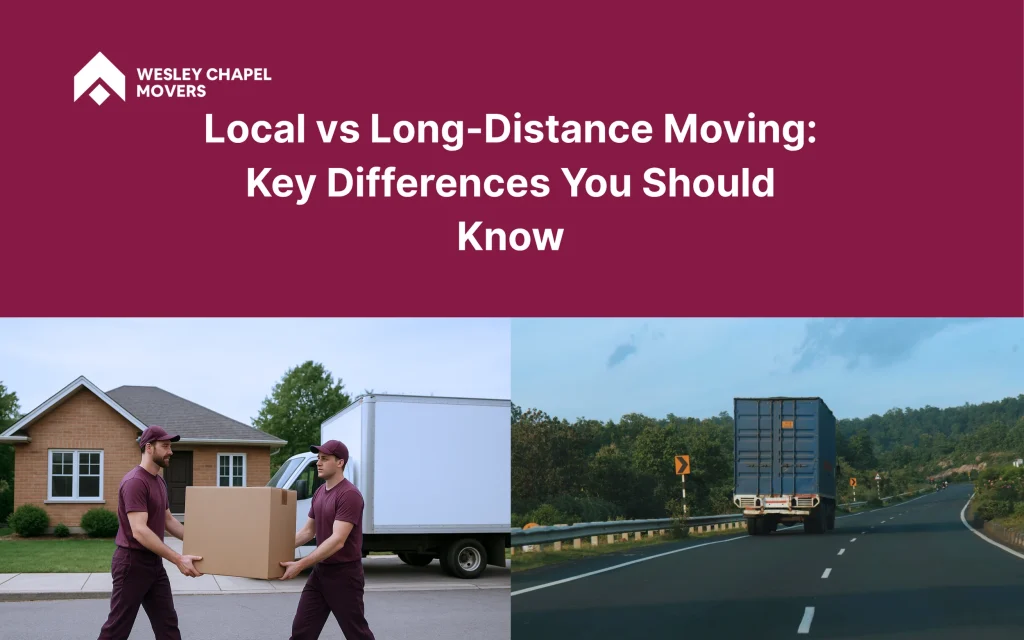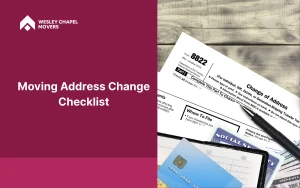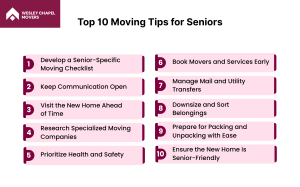The key difference between local and long-distance moving lies primarily in the distance and the complexities associated with it. While both types of moves involve packing, transporting, and unloading your belongings, the factors that influence the process, such as cost, time, and logistics, differ greatly depending on how far you are moving.
A local move is typically confined to a smaller geographic area, often within a 100-mile radius, and is generally quicker and more straightforward. On the other hand, a long-distance move covers much larger distances, often crossing state lines or even coast-to-coast, and requires more extensive planning, resources, and coordination.
Whether you are moving across the street or across the country, understanding these differences is crucial. They affect not only the cost but also the timeframe, planning, and resources needed for a smooth relocation. By recognizing the unique factors of local vs. long-distance moves, you will be better prepared to choose the best option for your needs, saving both time and money.
What Is a Local Move?
A local move, also called an intrastate move, is a short-distance relocation typically within a 50–100 mile range. These moves usually take place within the same city, county, or metro area. Because local moves stay within a limited area, they are simpler and more efficient. Most can be completed in just one day or even a few hours, which significantly reduces labor and transportation costs. With fewer variables such as fuel, tolls, and travel delays, local moves are generally more affordable (ranging from $450 to $2,500) and easier to plan than long-distance relocations.
What Is a Long-Distance Move?
A long-distance move, also known as an interstate or cross-country move, involves relocating over a greater distance, typically beyond 100 miles. These moves often require crossing state lines and can cover large regions or even the entire country. Because long-distance moves span much greater distances, they are more complex and require additional time, resources, and planning. The process can take several days or even weeks, depending on the distance and logistics. The cost of these moves is generally higher, ranging from $2,200 to $10,000+, due to factors such as fuel, tolls, travel delays, and the need for extra services like packing and insurance.
Cost Differences Between Local & Long-Distance Moves
Local moves are less expensive than long-distance moves due to shorter distances, lower fuel costs, and simpler logistics. However, the higher cost of long-distance moves, particularly cross-country, is justified by factors like increased fuel consumption, potential storage needs, and additional insurance. Understanding these pricing differences and factors affecting them can help you budget effectively and make an informed decision based on your needs.
Local Move Pricing
For local moves, movers typically charge based on an hourly rate (generally $80 to $200 per hour per mover), with costs depending on the time required to complete the move and the number of movers needed. Generally, local moves tend to be more affordable, with costs ranging between $450 and $2,500, since they require less time and fewer resources. The price may also vary depending on the size of the move, whether it involves any special items, or the need for additional services like packing.
Long-Distance Move Pricing
Long-distance moves are priced primarily based on the weight of your belongings and the distance of the move. Unlike local moves, which are charged by the hour, long-distance moves take into account the volume of goods, mileage, and any extra services such as packing, crating, or insurance. These moves are usually more expensive due to factors like increased fuel costs, more labor, and the need for specialized logistics. For an easy, stress-free moving experience, professional long-distance movers can help ensure your move goes smoothly.
Typical Cost Range for Each Type
The cost range for both local and long-distance moves can vary significantly based on factors such as distance, number of movers, and the time required. On average, a local move typically costs between $450 and $2,500. This can vary depending on your location and the size of your home. For example, a small one-bedroom apartment will usually fall on the lower end of the range, while a larger three-bedroom home will be on the higher end.
Whereas long-distance moves are significantly more expensive, with typical costs ranging from $2,200 to $10,000 or more. These prices are based on national averages but fluctuate greatly depending on the distance and the weight of your belongings. For instance, a cross-country move will naturally cost much more than a move to a neighboring state. These estimates can also change based on location, size of the move, and any additional services required.
The wide price gap between local and long-distance moves is due to the difference in resources needed. Local moves are typically completed in a single day and are charged hourly. Long-distance moves, however, involve much more complex logistics, including higher fuel costs, more labor, and additional transportation time, all contributing to the higher price.
Understanding the Key Differences in Cost
The major difference in cost between local and long-distance moves is driven by the way each type of move prices its services. For local moves, the primary cost drivers are time and labor. Movers typically charge a flat hourly rate for their crew and truck, so the total cost is directly tied to how long the move takes. This straightforward model works well for short distances with fewer variables.
On the other hand, long-distance moving costs are determined by weight, distance, and additional services. The heavier your shipment and the farther you need to travel, the more you will pay. This pricing structure accounts for significant cost drivers like fuel, tolls, and the increased labor required for long-haul transportation. Ultimately, long-distance moves inherently involve more logistical and transportation costs, which leads to a significantly higher price tag than local moves.
Factors Influencing Cost
Several key factors influence the overall moving costs, which include the distance of the move, the size and weight of your belongings, and the time of year you choose to move. Here are the extra cost drivers for each type of move:
- Weight and distance of the move: Heavier loads and longer distances increase costs, particularly for long-distance moves, due to higher fuel consumption, labor, and vehicle wear.
- Additional services: Services like packing, furniture disassembly, and crating raise costs, especially for long-distance moves where protection is essential.
- Fuel and tolls for long-distance moves: Long-distance moves incur additional charges for fuel and tolls, which increase with the route length.
- Insurance coverage and liability: While basic liability is standard, additional insurance is recommended for long-distance moves to protect against damage during transit.
- Labor and hourly rates: The number of movers and the time they spend on the job directly impact the cost of local moves, which are typically billed by the hour.
- Type of vehicle and equipment needed: Larger homes or oversized items require bigger trucks and specialized equipment, raising costs for both local and long-distance moves.
- Accessibility of pick-up and delivery locations: Difficult-to-reach locations, such as apartments with stairs or long driveways, may incur extra charges for the added effort.
Moving Time Frame & Duration
The time it takes to complete a move varies significantly between local and long-distance relocations. While a local move can often be completed in a single day, a long-distance move requires a longer timeframe due to the distance and added logistical complexities. Therefore, understanding the typical duration for each type of move can help you plan and set realistic expectations for your relocation.
Local Move Timing
A typical local move can often be completed in a single day, usually within a few hours. Movers typically load your furniture and boxes in the morning and have everything unloaded at your new place by the afternoon or evening. Even with a large amount of belongings, the move is completed in one trip or just a few short back-and-forths. This timeline means you do not have to worry about being without your belongings for too long. Additionally, local moves offer flexibility in scheduling, allowing you to choose a start time that suits you, as there is no need to account for multi-day travel.
Long-Distance Move Timing
A long-distance move is a much longer process, typically taking several days or even weeks to complete. The extended timeline is due to the significant travel distance and the complex logistics involved. Unlike local moves, the journey itself is a major factor in the timeline, often requiring overnight stops for the moving crew. The duration can also be influenced by the number of miles, the specific route, and unexpected delays from weather or traffic. This means long-distance moves require detailed scheduling and a larger delivery window, so it is essential to be prepared for the possibility of delays.
Scheduling Differences Between Local and Long-Distance Moves
Scheduling a move is generally far more complex for a long-distance relocation. For a local move, the process is continuous. The same crew that loads your belongings in the morning will drive directly to your new home and unload them, all in one day. This quick turnaround provides significant flexibility, allowing you to often choose a specific date and time that is most convenient for you.
On the other hand, long-distance moves require a more rigid schedule. The moving company must account for factors like a driver’s hours-of-service regulations and potential transfer points where your belongings may be combined with other shipments. This means the company provides a delivery window rather than a precise date. As a result, long-distance moves require more patience and advanced planning, while local moves offer the convenience of a quick, same-day turnaround.
Logistics & Planning
Moving logistics and planning involve a series of key aspects, including a detailed timeline, planning, and coordinating transportation. Understanding these factors can make a huge difference in ensuring a smooth and efficient experience.
Scale of the Move
The scale of the move refers to the size and complexity of the relocation. Local moves are generally smaller in scale, requiring shorter distances, fewer resources, and less preparation. However, long-distance moves, especially those involving large homes or significant amounts of belongings, require more extensive planning. The size of the move directly impacts the number of movers, the amount of equipment needed, and the duration of the move. Larger moves typically involve more coordination to ensure everything is packed, transported, and unpacked efficiently.
Crew & Coordination
The coordination required for local and long-distance moves differs significantly. Local moves typically require fewer movers and less coordination, as the logistics are simpler and the move is completed within a single day. In contrast, long-distance moves involve more movers and extensive coordination due to the complexity of managing longer distances, multiple stops, and larger shipments. Ultimately, larger, more complex moves, such as long-distance relocations, demand a more detailed plan and careful team coordination for an effective and smooth transition.
Routing & Transport
For a local move, the routing is direct and typically involves a single trip on local roads with a smaller truck. The entire process is a direct journey from one location to another. A long-distance move requires much more extensive planning. The route is more complex, often spanning highways and multiple states, and may involve larger transport vehicles like 18-wheelers. This requires a professional logistics team to plan the most efficient path and ensure compliance with federal transport regulations, making the routing and vehicle requirements a key factor in the overall complexity of the move.
Contingencies
Preparing for contingencies is a key part of moving, especially for long distances. While both local and long-distance moves can face unexpected challenges like traffic or weather, the impact is far more significant for a long-distance relocation. A delay on a local move might add an hour to your day, but a major storm or highway closure on a cross-country move could result in a multi-day delay. This increased risk makes it crucial to have a flexible schedule and an emergency plan for long-distance moves, whereas local moves have a much lower risk of significant delays due to their short, direct nature.
DIY Differences
When deciding between a DIY move and professional moving services, the key difference lies in the complexity of the move. For local moves, a DIY approach can be more suitable, as these moves generally involve fewer items, shorter distances, and less planning. However, long-distance moves are far more complex, requiring specialized services such as larger vehicles, more logistics, and longer transport times. Due to these challenges, professional movers are typically necessary for long-distance relocations to ensure the safe and efficient handling of your belongings.
Regulations & Legal Considerations
Whether you are moving down the street or across the country, navigating the legal and regulatory landscape is crucial for a smooth, hassle-free experience. This includes knowing your rights and responsibilities as a consumer, choosing a licensed and trustworthy moving company, and securing adequate insurance to protect your belongings throughout the move.
Intrastate Move Regulations
Local moves are regulated at the state level, with each state setting rules for moving companies, such as licensing, minimum insurance, and dispute resolution. Unlike interstate moves, there is no single federal law, so oversight is localized. Protections for local moves are generally defined by state consumer laws and your mover’s contract. Some states have agencies, like transportation departments or public utilities commissions, to oversee services and handle complaints, but generally, the process is straightforward when you hire a reputable mover.
Interstate Move Regulations
Long-distance interstate moves, which involve crossing state lines, are governed by both federal and state laws. Federal regulations, overseen by the Federal Motor Carrier Safety Administration (FMCSA), a division of the U.S. Department of Transportation, set strict rules that interstate moving companies must follow. These rules include providing important documents like the “Your Rights and Responsibilities When You Move” booklet, offering specific liability coverage options, and giving binding or non-binding estimates. All interstate movers must also be registered with the U.S. DOT and have a valid USDOT number. The FMCSA’s rules are designed to protect consumers from fraud and ensure fair practices, so you can expect a bit more paperwork with a long-distance move.
State vs. Federal Oversight
The key difference between state and federal oversight lies in jurisdiction. Local moves are governed by state regulations, with each state establishing its own rules for movers, including licensing requirements and insurance mandates. Long-distance moves fall under federal regulations, overseen by the Federal Motor Carrier Safety Administration (FMCSA). The FMCSA ensures a consistent framework for movers crossing state lines, including liability coverage and consumer rights. It is crucial to verify that your mover is properly licensed for the type of move you are making, whether local or long-distance.
Impact of Regulations on Your Move
Moving regulations can significantly influence the logistics, cost, and planning of your relocation. For local moves, state-specific rules may dictate licensing, insurance requirements, or permits, which can affect scheduling and service options. Long-distance, interstate moves are subject to federal regulations, adding layers of documentation, compliance, and potential fees that can increase both complexity and cost. Being aware of these requirements ahead of time helps you plan effectively, ensures a smoother move, and prevents delays or unexpected expenses from non-compliance.
Comparing the Benefits and Challenges of Local vs Long-Distance Moves
Moving, whether local or long-distance, comes with its own unique set of benefits and challenges. Local moves are generally faster, more affordable, and require less planning. Long-distance moves, on the other hand, offer more comprehensive services and professional handling but come with higher costs and more complex logistics.
Benefits of Local Moving
Local moves offer several advantages due to their shorter distances and simpler logistics, including cost-effectiveness, flexibility, and faster completion.
- Cost-effective: Local moves are less expensive due to shorter distances and fewer resources required.
- Faster completion: With the local move, the move is completed in a few hours or a single day, offering quick turnover.
- More flexibility: Scheduling is easier with fewer logistical constraints and no multi-day travel involved.
- Easier to coordinate: Local moves require less planning and fewer resources, making coordination simple and stress-free.
Challenges of Local Moving
Despite their benefits, local moves can come with challenges and limitations of services and flexibility, especially in smaller areas, and certain specialized services available for long-distance moves may not be offered locally.
- Limited service options: Local moves often have fewer specialized service choices due to the smaller scale of the move.
- Less flexibility in timing: Scheduling for local moves can be limited during peak times or in busy areas.
- Limited storage options: Local moves may have fewer storage facilities available, especially in densely populated areas.
Benefits of Long-Distance Moving
Long-distance moves offer a wide range of service options and are well-equipped to handle larger inventories. These moves often include expert packing services, specialized storage, and cross-country tracking, ensuring that your belongings are well-protected during transit.
- Wider service options: Long-distance moves offer more services like professional packing and storage.
- Professional packing and protection: With long-distance moving, you will have the option for expert packing, ensuring items are safe during long transit times.
- Larger inventory moves possible: Long-distance movers are equipped to manage larger, bulkier items, accommodating larger households or offices.
- Cross-country tracking: This type of move often comes with tracking systems to give real-time updates on your belongings.
Challenges of Long-Distance Moving
Long-distance moves come with several challenges, including costs, longer timeframes, and increased risk of damage. The extended distance and complex logistics make these moves more expensive and time-consuming compared to local relocations.
- Higher cost: Greater distances, fuel, and logistics make long-distance moves more expensive.
- More time-consuming: The longer travel time, complex logistics, and need for more planning make long-distance moves significantly more time-consuming
- Increased risk of damage: The longer your items are in transit and the more they are handled, the higher the risk of damage.
- Limited flexibility: Due to fixed routes, driver regulations, and logistics, long-distance moves have much less flexibility in scheduling.
Tips to Overcome Moving Challenges
Moving can be stressful, but the right preparation helps minimize common challenges like scheduling, packing, and transport. Whether it is a local move or a long-distance relocation, having a solid plan can save time, reduce stress, and keep costs under control. Compared to local moves, long-distance moves, the process often require more planning and resources, which is why following these long distance moving tips can make all the difference.
- Book the moving company in advance: It is crucial to book your movers as early as possible, especially for a long-distance move, which requires more planning and has limited availability. For a smooth process, consider contacting a reliable moving service well in advance.
- Use checklist: A detailed checklist helps you stay organized, ensures you do not miss any critical steps, and increases efficiency. While this is important to have for both local and long distance moves, having a checklist for long-distance moves can prove to be useful.
- Leave room for flexibility: Local moves are usually easier to schedule and allow more adaptability. Build in some flexibility in case of delays, weather, or other unexpected issues.
- Use protective packing materials: To prevent damage to your fragile or valuable items, use high-quality protective materials like bubble wrap, packing paper, and moving blankets.
- Label boxes clearly: Always label boxes with both the contents and the destination room. This simple step saves time, reduces confusion, and makes unpacking more efficient.
- Choose the right vehicle: The size of your move should dictate your choice of vehicle. For local moves, a smaller truck may be sufficient, but a long-distance move often requires a larger truck or professional specialized transport.
- Prepare for long travel times: For a long-distance move, be prepared for extended travel times. Consider factors like weather conditions, potential traffic delays, and the need for driver breaks.
- DIY moves are cost-effective: For smaller local moves, DIY can save money since you avoid labor costs. Renting a truck and doing the work yourself is often more budget-friendly.
- Professional movers handle logistics: For long-distance moves, professional movers are essential. They handle all the complex logistics, from routing and vehicle management to paperwork and compliance, ensuring a smooth relocation.
When to Choose Local Movers vs. Long-Distance Movers
Choosing between a local mover and a long-distance mover is a critical decision that primarily depends on the distance of your relocation. While local movers are ideal for short-distance moves, professional long-distance movers are essential for cross-country relocations due to the complexities involved.
- Distance Determines the Category
As a general rule, if your new location is within the same city or a short distance within a single state, choosing a local move is the best option. These moves are best handled by local movers who are familiar with the area and specialize in short-haul transport. If your move crosses a state line, a long-distance mover is required. These movers are equipped and legally licensed to handle the extensive travel, complex logistics, and federal regulations associated with interstate relocations.
- Advantages of Local Movers
For short-distance moves, local movers offer clear advantages in terms of both cost and convenience. They are ideal if you only need assistance at one end of the move, as many offer labor-only services by the hour. If you are looking to keep costs low, you could even rent a truck and hire local labor for the heavy lifting. However, this approach is not feasible for long-distance relocations, where a professional long-distance mover is the safer and more reliable option.
- Necessity of Long-Distance Movers
For long-distance moves, hiring a professional mover is not just a convenience, as it is a necessity. These moves require specialized equipment, logistical expertise, and a knowledge of federal regulations. A professional long-distance moving company can handle a larger inventory, provide professional packing services, and ensure the safe transport of your belongings over thousands of miles. To ensure a smooth and organized process, it is wise to follow a detailed long distance moving guide.
- Verify with Your Mover
Regardless of the distance, you should always verify that a mover can handle the specific needs of your relocation. For a local move, ensure they are properly licensed within your state. For a long-distance move, confirm that they have a USDOT number and are registered with the FMCSA. This due diligence ensures your move is handled by a reputable and qualified company.
- Personal Comfort & Peace of Mind
With both options being available, your decision should also be guided by your own personal comfort and peace of mind. If the thought of coordinating a complex move feels overwhelming, it may be worth hiring a full-service, long-distance mover, even for a shorter trip. This option provides a comprehensive, door-to-door experience that handles every detail. Whereas, if your move is a simple one to the next town over, you might prefer the personal service of a local, family-owned company. The choice is not just about distance, it is about the level of service and security you need to feel confident in your relocation. Local movers are great for quick jobs, while long-distance movers specialize in the endurance and logistics of a long haul.







